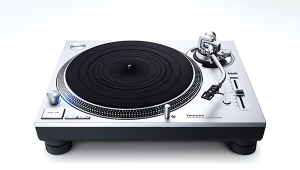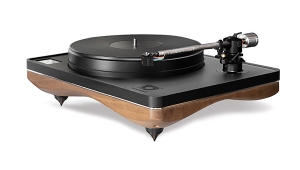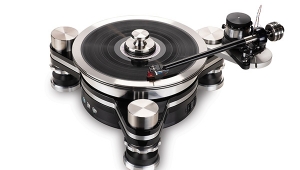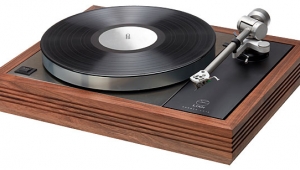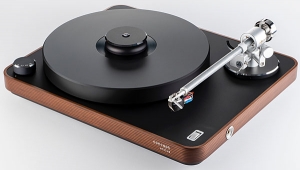| Columns Retired Columns & Blogs |
Basis Audio Ovation turntable Page 2
Needless to say, no record mat of any kind should be used with the Ovation. The insertion of any type of mat only serves to break the coupling between platter and record. To improve that coupling, a record clamp is provided. It fits over the spindle and allows the application of considerable pressure to the record—at least over the label area. Though quite effective with flat or slightly convex records, it is unable to keep the entire surface area of a dished record in contact with the platter. This is where a vacuum holddown system has a significant edge.
Also noteworthy is the attention paid to armboard design. Made of dense acrylic and lead, the armboard is more massive than some platters, and well-damped, even if its thickness and composition make drilling a blank board quite a challenge. Basis advises the purchaser to obtain a pre-drilled board from the dealer.
The Ovation has an oil-well bearing with a 0.5" shaft diameter. All wear faces are made of tungsten carbide. The bearing/bushing tolerances are held to an impressive – .0001" to assure a uniform lubrication gap. One of the potential problems of this sort of bearing, especially at low rpm, is the establishment of a "hydrodynamic" oil film between the bearing surfaces. The Ovation's large-diameter bearing increases the relative linear velocity between the bearing surfaces and thus helps maintain a low-friction oil film. The platter/bearing assembly is tested and aligned at the factory, and the optimum alignment is marked for proper assembly by the end user.
The Ovation's subchassis assembly is suspended from two aluminum support arms. In effect, the subchassis floats atop four suspension cartridges. Each suspension cartridge consists of silicone fluid damping and a steel spring attached to the support arm. In engineering terms, a sprung isolation system is usually modeled with mechanical elements of mass, spring, and resistive dashpot (damper). A.J. Conti feels that only when each of these three parameters (ie, mass, spring rate, and damping constant) can be independently set is it possible to optimize the isolation system. He points out that if the damper also has a spring element (such as all foam rubbers, rubber, and Sorbothane), then the designer has already forfeited the ability to completely control the system.
Fortunately for A.J., steel springs behave nearly ideally, with almost no damping component; the vertical resonant frequency may be set using the ideal spring equation. The horizontal motion of the suspension mimics that of a pendulum, so that the resonant frequency in the horizontal axis may be set via the classical equation for pendulum motion. Therefore, the Ovation's suspension allows the designer to independently set the vertical and horizontal natural resonance frequencies.
The Q of the resonances is controlled by the silicone fluid. The ideal damper would oppose motion with a force proportional to the velocity of motion of the system. Damping with a noncompressible fluid more nearly follows this ideal behavior than would damping with foam rubbers, Sorbothane, or other types of compressible materials. Since steel springs, unlike rubber, neither age nor exhibit hysteresis effects, and because the springs are used well below their elastic limit, the suspension system is said to be absolutely stable over time, requiring no adjustments ever. A.J. claims that you can stand on the subchassis without overstressing it. I passed.
As a demonstration of the stability of the Ovation's suspension system, A.J. Conti invited me to take it for a test drive. First, he asked me to excite the vertical mode by repeatedly bouncing the subchassis from only one corner. Indeed, the subchassis motion was strictly vertical, without any horizontal tipping, and all motion was very quickly damped when I stopped the excitation. Next, he asked me to excite the subchassis torsionally by twisting and releasing it. Again, the motion was controlled and well-damped, without any high-frequency oscillation. The point, according to A.J., is to show that the suspension exhibits no harmonic behavior above its fundamental natural frequencies in the vertical, horizontal, and torsional directions. This gives the Ovation excellent rejection of structural vibration from footfalls up through the audible range.
Preliminaries
Instructions for assembly of the Ovation are well-thought-out and clearly presented. However, a couple of photos or sketches would have moved things along a bit faster. The assembly process proceeded uneventfully except for the installation of the suspension cartridges. The instructions call for pulling the top of the cartridge through the top of the support arm. This required a vigorous yank rather than the gentle pull implied by the instructions. Also, a bit later, after I realized that the subchassis could not be raised sufficiently to hang at the correct height by merely adjusting the cartridge springs, I had to remove all four suspension cartridges and add a couple of O-rings (eight spare O-rings came with the 'table) over the ridge in each cartridge that the subchassis sits on. Together with the O-ring installed at the factory, that made for a total of three O-rings on each cartridge.
In went the cartridges again. Even so, the subchassis still hung so low so that the cartridges were bottoming out. Having run out of O-rings, I was forced to shim up the feet of the base to get adequate clearance for the bottom of the suspension cartridges. Had the feet on the 'table's base been adjustable, this would not have been necessary, and would have made leveling the 'table much easier.
I placed the Ovation atop my Lead Balloon Stand, using a homemade platform for support. The armboard had been pre-drilled to accept the SME-type mount of the Graham Engineering Model 1.5 tonearm. However, it became obvious that the Ovation had not been designed with the Graham's needs in mind. (In all fairness, the Ovation was finalized before the Graham arm was a commercial reality.)
There were two major incompatibilities. First, the cutout in the bottom of the armboard was too small in diameter to accommodate the DIN-type connector of the Graham arm's interconnect cable. There wasn't enough clearance, even when rotating the bottom of the arm shaft, to squeeze the 1.25" barrel of the female connector at right angles to the arm shaft in order to line it up with the male jack. I had to remove the barrel of the connector before I could mate the cable to the arm. I eventually obtained a specially fabricated interconnect cable from Graham Engineering, one without the bulky barrel and sheathed in heatshrunk tubing to protect the DIN connector. This cable was also long enough to allow me to bypass the arm's phono-jack box and connect directly to the preamp.
- Log in or register to post comments
